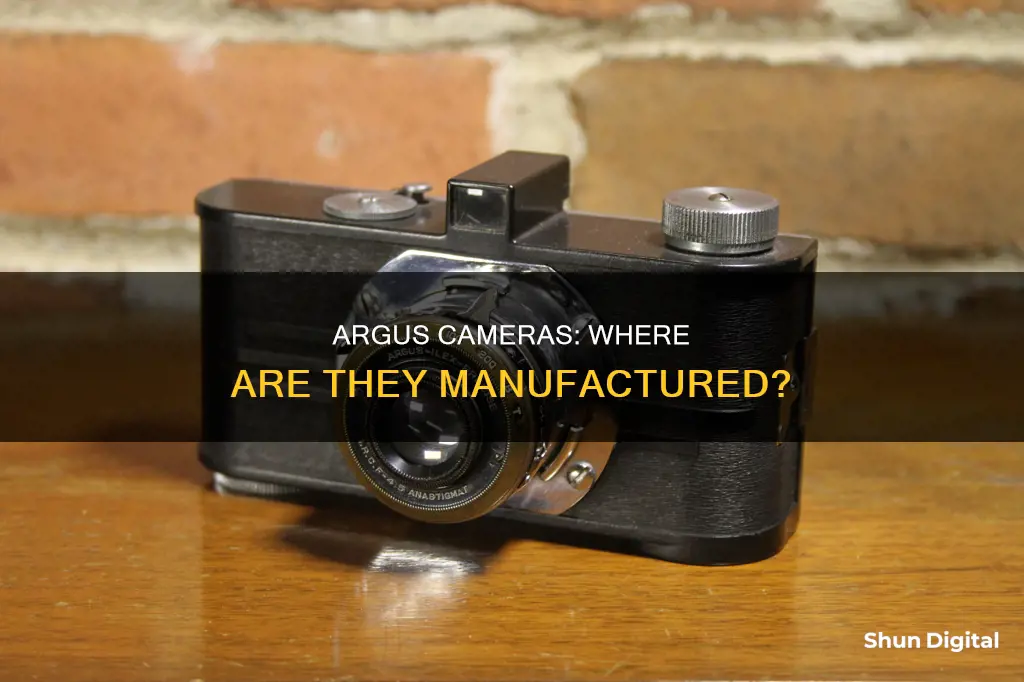
Argus Cameras, Incorporated was founded in Ann Arbor, Michigan, in 1936. The company was originally known as the International Radio Corporation, founded in 1931 by local businessmen including William E. Brown Jr., who later became the mayor of Ann Arbor, and Charles Albert Verschoor, who became the company's president. The company's first camera, the Model A, was introduced in 1936 and was the first low-cost 35mm camera in the United States. Over the years, Argus became a significant force in Ann Arbor's economy and changed its name several times, eventually becoming Argus Cameras, Inc. in 1949. The company's best-known product was the C3 rangefinder camera, which was produced for 27 years and became one of the top-selling cameras in history.
| Characteristics | Values |
|---|---|
| Original Founder(s) | Charles A. Verschoor, Mayor William E. Brown Jr., George J. Burke |
| Year Founded | 1936 |
| Original Name | International Radio Corporation |
| Original Location | Ann Arbor, Michigan, USA |
| Current Owner | Argus Camera Company, LLC. |
| Current Location | Inverness, Illinois, USA |
What You'll Learn

The company was founded in Ann Arbor, Michigan, in 1936
The Argus Camera Company was founded in Ann Arbor, Washtenaw County, Michigan, in 1936. The company was originally founded as the International Radio Corporation in 1931 by a group of local businessmen who wanted to revitalise the area and create jobs during the Great Depression. These businessmen included William E. Brown Jr., who later became the mayor of Ann Arbor, and Charles Albert Verschoor, who became the company's president.
In 1936, the company introduced its first camera, the Model A, which was an affordable 35mm camera priced at $12.50. The success of the Model A and the popularity of the company's subsequent photographic products led to the company changing its name to International Research Corporation and making cameras their primary business.
The Argus Camera Company became a significant force in Ann Arbor's economy, with several buildings from its heyday still standing today. The company's best-known product was the C3 rangefinder camera, which had a 27-year production run and became one of the top-selling cameras in history. By the end of World War II, Argus had won the Army-Navy "E" Award five times for "excellence in design and manufacture of war-related material".
In 1957, Argus was acquired by Sylvania Electric Products Co., and the company slowly moved out of Ann Arbor. By 1969, all domestic camera production had ended, and the Argus brand was owned by a series of companies that imported photographic products labelled as 'Argus'. Despite the company's evolution and changes in ownership, the Argus Camera Company's founding in Ann Arbor, Michigan, in 1936, remains a significant milestone in its history.
The Sweet Journey: Chocolate's On-Camera Making
You may want to see also

The International Radio Corporation was the predecessor to Argus
The International Radio Corporation (IRC) was founded in 1931 in Ann Arbor, Michigan, by Charles Albert Verschoor, who had been making radios since the 1920s. The company was initially financed with $10,000 raised by Ann Arbor mayor William E. Brown, Jr., and a group of local business leaders. The IRC was created to stimulate the local economy and create jobs during the Great Depression.
IRC manufactured and sold radios, many under the name Kadette. The company's first radio was the International Duo, which was released in August 1931. It was followed by the Kadette, the first mass-produced AC/DC radio, which was small and easily portable. The Kadette's plastic cabinet, made by the Chicago Molded Products Company, was the first to be used on a radio, though its Gothic styling gave it a traditional appearance. The Kadette was a commercial success, leading to "almost immediate profitability" for the IRC.
Following the Kadette's success, the company released several other radio models, including the Kadette Jr., the world's first pocket radio; the Kadette Jewel, which was available in five different colour combinations; the Kadette Classic, built with three types of plastic; and the Kadette Clockette, which resembled a small mantel clock and was available in four different wooden case styles. The IRC also introduced several related accessories, including the Tunemaster, a portable radio remote control, and the Kadette Autime, the first mass-produced clock radio.
In 1936, IRC president Charles Verschoor decided to expand the company's product line to reduce the impact of the seasonal nature of radio sales. He settled on the idea of producing an inexpensive camera similar to the Leica, which would ultimately become the Argus. The Model A camera was released in May 1936 and was an instant success, selling 30,000 units in the first week.
In 1939, the IRC sold its radio-manufacturing business to its former General Sales Manager, W. Keene Jackson, who renamed it the Kadette Radio Corporation. However, this new company only survived for a year before going out of business. After World War II, International Industries and its International Research division became wholly owned subsidiaries of Argus, Inc., and the International name ceased to exist.
Camera Stabilization: Power Drain or Creative Gain?
You may want to see also

The Argus Model A was the company's first camera
The Argus Camera company was founded in 1936 in Ann Arbor, Michigan, by Charles Verschoor, William E. Brown Jr., and George J. Burke. The company's first camera, the Argus Model A, was introduced in May 1936.
The Argus Model A was a significant innovation in the camera industry. It was the first low-cost 35mm camera in the United States, with an affordable price of $10 to $12.50. This accessibility made 35mm photography available to amateur photographers who could not afford more expensive cameras such as the Leica, Zeiss Contax, or German Kodak Retina. The Argus Model A was a huge success, with over 210,000 units sold between 1936 and 1941.
The Argus Model A had several notable features. It had a collapsible lens for compact carrying, a frame counter, and a removable back for easy film loading. The camera's body was made of Bakelite, a strong and serviceable plastic material that was inexpensive to produce. This made the Argus Model A one of the first plastic-bodied cameras. The camera's design resembled the more expensive Leica A, with a relatively small size and two-position zone focusing.
The popularity of the Argus Model A helped establish 35mm as the preferred film format for serious amateur photographers in the United States. The success of the Argus Model A and its subsequent models, such as the Argus C and Argus C2, contributed to the company's growth and impact on the camera industry. By the 1950s, Argus had become a significant economic force in Ann Arbor, Michigan, and their best-known model, the Argus C3, sold nearly three million units.
Understanding Panasonic's RAW File Extension for Lumix Cameras
You may want to see also

By the 1950s, Argus was a significant force in Ann Arbor's economy
Founded in 1936, Argus Cameras, Inc. was a significant force in Ann Arbor's economy by the 1950s. The company was originally founded as the International Radio Corporation in 1931 by local businessmen from Ann Arbor, Michigan, including William E. Brown Jr., who later became the mayor of Ann Arbor, and George Burke, a judge at the Nuremberg War Crimes Trial. The company aimed to create jobs during the Great Depression.
In 1936, the company introduced its first camera, the Model A, at an affordable price of $12.50, which was unheard of for a 35mm camera at the time. The success of the Model A, along with the subsequent popularity of an expanded line of photographic products, led the company to sell its radio patents and make cameras their primary business.
During World War II, Argus devoted its production to military optics and radio equipment for the US and allied armed forces. By the end of the war, the company had won the Army-Navy "E" Award for outstanding war production five times.
After the war, Argus resumed civilian production and became the second-largest manufacturer and distributor of camera equipment in the United States by the 1950s, only surpassed by the Eastman Kodak company. Their best-known product, the Model C3 camera, was introduced in 1939 and became known as "the brick" due to its shape. The C3 enjoyed a 27-year production run and became one of the top-selling cameras in history.
By the 1950s, Argus had become a significant economic force in Ann Arbor, employing 1300 workers and occupying two city blocks on 4th Street. Several buildings from its heyday still stand, including the main original factory, now remodelled as office space, and two buildings used by the University of Michigan.
The Evolution of Smartphone Cameras: How Are They Made?
You may want to see also

The Argus C3 was the company's best-known product
The Argus C3 was introduced in October 1939 as an improved version of the C (1938) and C2 (1938–1942). All three models shared the same "brick" design, attributed to Gustave Fassin, but the C3 was by far the most successful. The original Argus C was equipped with an uncoupled rangefinder, while the C2 coupled the rangefinder to the lens to allow one-step focusing. The C3 added built-in flash synchronisation but was otherwise identical to the C2. It originally retailed for $35, equivalent to $767 in current dollars.
The C3 was constructed primarily of bakelite with metal castings for the front and back. The design featured an unusual but simple diaphragm shutter built into the camera body, so the camera could make use of interchangeable lenses without the need for a complex focal plane shutter. The camera came equipped with a 50mm f/3.5 Cintar anastigmat triplet lens. The lenses were made under contract by Bausch & Lomb, Ilex, and Graf Optical, which was taken over by Argus in 1939, with varying quality.
The C3 proved hugely successful, selling approximately 2 million units during its 27-year production run. Although the boxy design was neither stylish nor ergonomic, customers were reportedly drawn to the camera's "`scientific`" appearance with its many gears, knobs, and dials. The C3 also developed a reputation for rugged durability and sharp, high-quality images. Photographers affectionately nicknamed it "the brick".
The C3's enduring popularity allowed it to outlast nearly all of its American competitors, including the Kodak 35 Rangefinder, but it was not able to compete with the flood of inexpensive Japanese single-lens reflex cameras that entered the market in the 1960s and was finally discontinued in 1966.
Disabling Night Owl Cameras: Display Mode Tips
You may want to see also
Frequently asked questions
Argus Cameras were originally made in Ann Arbor, Michigan.
Argus Cameras, originally known as the International Radio Corporation, was founded by local businessmen William E. Brown Jr., George Burke, and Charles Albert Verschoor.
The company was founded in 1931, during the Great Depression, with the aim of creating jobs in the area.
The first Argus camera was the Model A, introduced in May 1936.







